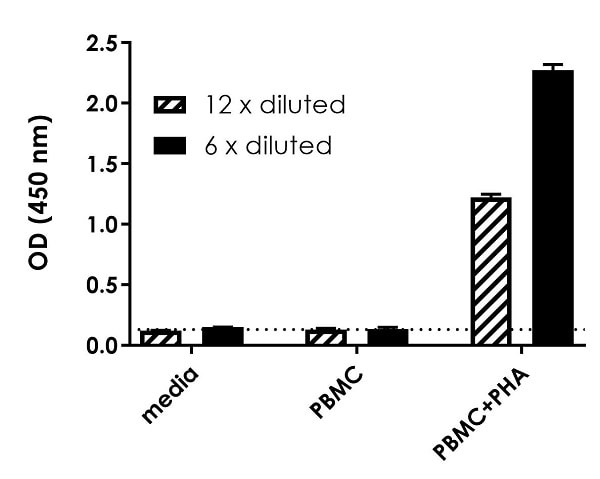Human IFN gamma ELISA Kit, Fluorescent (ab229415)
Key features and details
- One-wash 90 minute protocol
- Sensitivity: 25 pg/ml
- Range: 0.06 ng/ml - 30 ng/ml
- Sample type: Cell culture supernatant, Cit plasma, EDTA Plasma, Hep Plasma, Serum
- Detection method: Fluorescent
- Assay type: Sandwich (quantitative)
- Reacts with: Human
Overview
-
Product name
Human IFN gamma ELISA Kit, Fluorescent
See all Interferon gamma kits -
Detection method
Fluorescent -
Precision
Intra-assay Sample n Mean SD CV% Supernatant 5 1.1% Inter-assay Sample n Mean SD CV% Supernatant 3 7.9% -
Sample type
Cell culture supernatant, Serum, Hep Plasma, EDTA Plasma, Cit plasma -
Assay type
Sandwich (quantitative) -
Sensitivity
25 pg/ml -
Range
0.06 ng/ml - 30 ng/ml -
Recovery
Sample specific recovery Sample type Average % Range Cell culture supernatant 86 77% - 93% Serum 102 98% - 104% Hep Plasma 244 197% - 298% EDTA Plasma 122 117% - 124% Cit plasma 107 96% - 115% -
Assay time
1h 30m -
Assay duration
One step assay -
Species reactivity
Reacts with: Human -
Product overview
Interferon-gamma (IFNG) in vitro CatchPoint SimpleStep ELISA (Enzyme-Linked Immunosorbent Assay) kit is designed for the quantitative measurement of Interferon-gamma (IFNG) protein in human serum, plasma, and cell culture supernatant samples.
This CatchPoint SimpleStep ELISA kit has been optimized for Molecular Devices Microplate Readers. Click here for a list of recommended Microplate Readers.
If using a Molecular Devices’ plate reader supported by SoftMax® Pro software, a preconfigured protocol for these CatchPoint SimpleStep ELISA Kits is available with all the protocol and analysis settings at www.softmaxpro.org.The CatchPoint SimpleStep ELISA employs an affinity tag labeled capture antibody and a reporter conjugated detector antibody which immunocapture the sample analyte in solution. This entire complex (capture antibody/analyte/detector antibody) is in turn immobilized via immunoaffinity of an anti-tag antibody coating the well. To perform the assay, samples or standards are added to the wells, followed by the antibody mix. After incubation, the wells are washed to remove unbound material. CatchPoint HRP Development Solution containing the Stoplight Red Substrate is added. During incubation, the substrate is catalyzed by HRP generating a fluorescent product. Signal is generated proportionally to the amount of bound analyte and the intensity is measured in a fluorescence plater reader at 530/570/590 nm Excitation/Cutoff/Emission.
-
Notes
IFN gamma is produced by lymphocytes activated by specific antigens or mitogens. IFN gamma, in addition to having antiviral activity, has important immunoregulatory functions. It is a potent activator of macrophages, it has antiproliferative effects on transformed cells and it can potentiate the antiviral and antitumor effects of the type I interferons.
-
Platform
Pre-coated microplate (12 x 8 well strips)
Properties
-
Storage instructions
Store at +4°C. Please refer to protocols. -
Components 1 x 96 tests 100X Stoplight Red Substrate 1 x 120µl 10X Human IFNG Capture Antibody 1 x 600µl 10X Human IFNG Detector Antibody 1 x 600µl 10X Wash Buffer PT (ab206977) 1 x 20ml 500X Hydrogen Peroxide (H2O2, 3%) 1 x 50µl Antibody Diluent CPI - HAMA Blocker (ab193969) 1 x 6ml Human IFNG Lyophilized Recombinant Protein 2 vials Plate Seals 1 unit Sample Diluent NBP 1 x 20ml Sample Diluent NS (ab193972) 1 x 50ml SimpleStep Pre-Coated Black 96-Well Microplate 1 unit Stoplight Red Substrate Buffer 1 x 12ml -
Research areas
-
Function
Produced by lymphocytes activated by specific antigens or mitogens. IFN-gamma, in addition to having antiviral activity, has important immunoregulatory functions. It is a potent activator of macrophages, it has antiproliferative effects on transformed cells and it can potentiate the antiviral and antitumor effects of the type I interferons. -
Tissue specificity
Released primarily from activated T lymphocytes. -
Involvement in disease
In Caucasians, genetic variation in IFNG is associated with the risk of aplastic anemia (AA) [MIM:609135]. AA is a rare disease in which the reduction of the circulating blood cells results from damage to the stem cell pool in bone marrow. In most patients, the stem cell lesion is caused by an autoimmune attack. T-lymphocytes, activated by an endogenous or exogenous, and most often unknown antigenic stimulus, secrete cytokines, including IFN-gamma, which would in turn be able to suppress hematopoiesis. -
Sequence similarities
Belongs to the type II (or gamma) interferon family. -
Post-translational
modificationsProteolytic processing produces C-terminal heterogeneity, with proteins ending alternatively at Gly-150, Met-157 or Gly-161. -
Cellular localization
Secreted. - Information by UniProt
-
Alternative names
- IF 1
- IFG
- IFI
see all -
Database links
- Entrez Gene: 3458 Human
- Omim: 147570 Human
- SwissProt: P01579 Human
- Unigene: 856 Human
Images
-
SimpleStep ELISA technology allows the formation of the antibody-antigen complex in one single step, reducing assay time to 90 minutes. Add samples or standards and antibody mix to wells all at once, incubate, wash, and add your final substrate. See protocol for a detailed step-by-step guide.
-
The Interferon-gamma (IFNG) standard curve was prepared as described in Section 10.
-
PBMC were grown in the absence or presence of phytohemagglutinin (PHA) for 2 days. IFNG concentrations were measured in 12X and 6X diluted cell culture supernatants of the unstimulated PBMC and the stimulated PBMC, and media. Raw data values (mean +/-SD, n=3) are graphed. The dotted line represents zero sample background.
-
The concentrations of IFNG were interpolated from data values shown in Figure 3 using IFNG standard curve and corrected for sample dilution. The mean IFNG concentration was determined to be 1.8 ng/mL in unstimulated PBMC supernatants and 177.2 ng/mL in stimulated PBMC supernatants.













